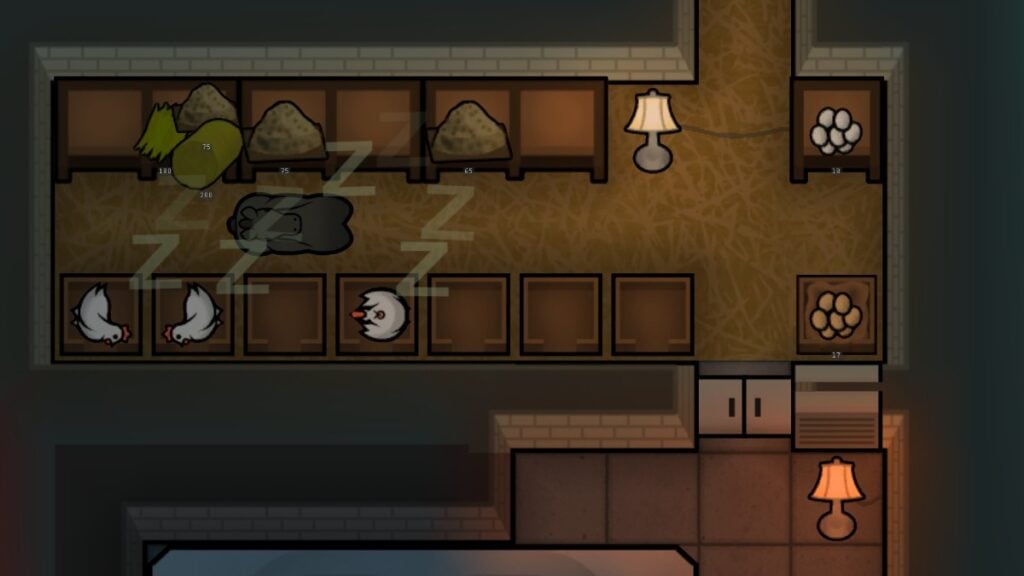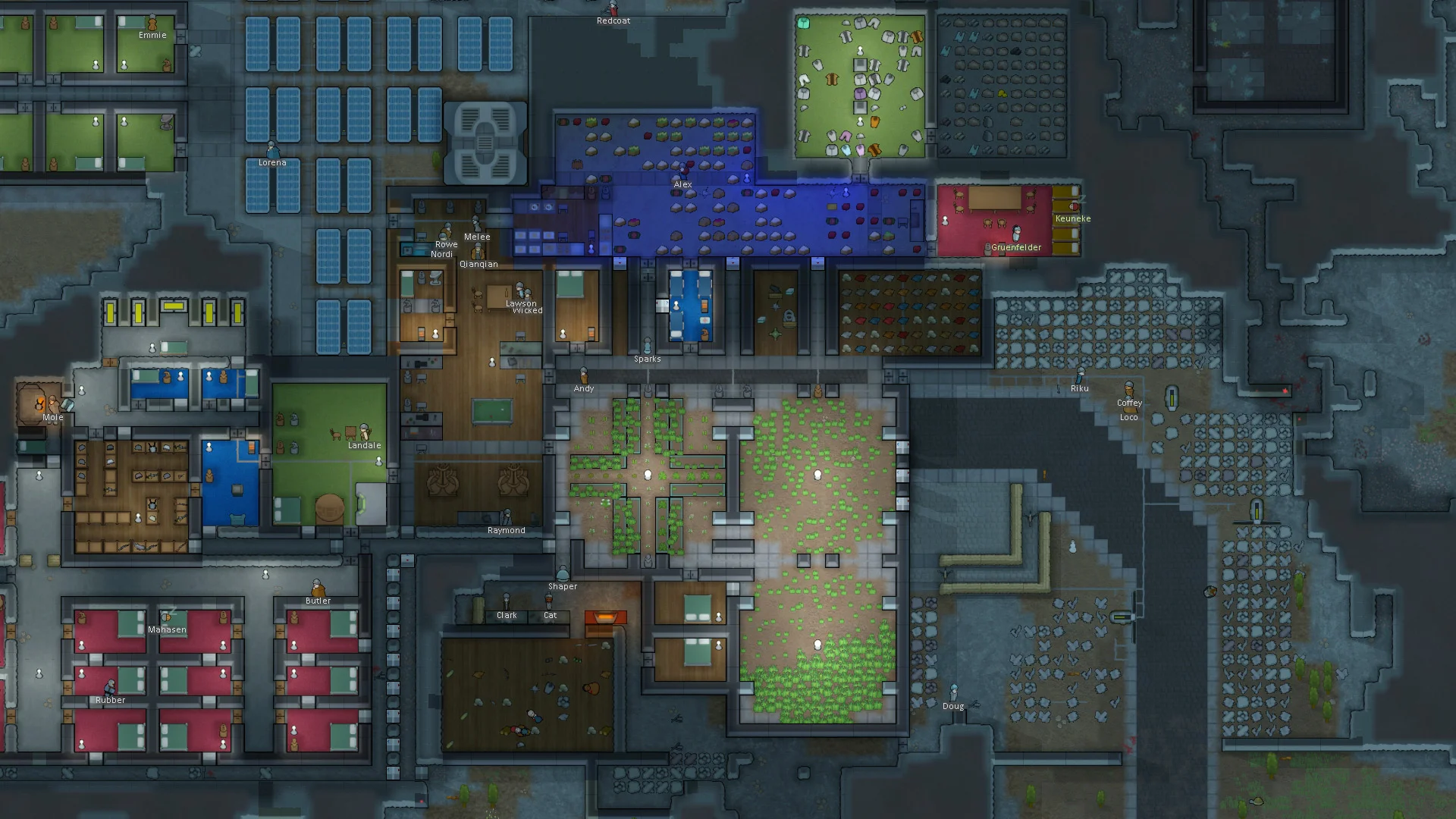Taming animals in RimWorld requires time, food, and animal handling skills required for bringing the wild beasts under your sway. Even colonies run entirely by vegans or cannibals will benefit from keeping animals around. Dogs can rescue downed colonists, alpacas provide wool for clothing, and cows provide milk for feeding babies. You can even raise grizzly bears as damage-absorbing tanks!
Our RimWorld animal guide will show you the ins and outs of raising animals out on the hostile planets. Let’s get started!
Animal Basics

Your best animal handlers will be capable of running a zoo on this hazardous RimWorld planet you’ve found yourself on. A colonist with the Animal Handling skill can walk up to an animal with some of its preferred food. After receiving some treats, the animal will be willing to follow your commands.
How to Feed & House Your Animals in RimWorld
A majority of animals will eat kibble, so it helps to keep a hearty supply of kibble on hand. It’s instrumental to keeping your animals well-fed without depleting your colonists’ food supply. You can also use haygrass to feed herbivores and as filler for your meat-based kibble.
Many animals will require you to construct a pen. This is best done with wood fencing in the early game, and with sturdier fencing or a full-sized wall later on. You’ll want to find a broad area full of grass, the bigger the better. These animals might need a temperature-controlled barn, depending on your climate and the individual temperature settings of the animal species. You can compare the animal’s preferences from their info tab with the expected minimum/maximum temperatures of your settlement.
Building a pen marker inside an enclosed area will give you some stats on how many animals the pen could potentially support without needing extra haygrass added to the area. Once you’ve constructed your pen, send qualified animal handlers out to tame wild animals with kibble or haygrass.
Wilder Animals
Some animals require your tamers to meet a minimum skill requirement. These animals are generally more rewarding to tame. Their “wildness” stat will be higher, requiring more maintenance taming to keep them under control.
There will also be some animals that don’t need to live inside a pen, as they’re tame enough to consider themselves part of your colony. You should assign these animals to a specific zone in your base. Leaving them “unrestricted” will mean they’ll be eating your colonist’s meals and making a mess in your kitchen. Make sure pets can’t hang out in food storage areas, kitchens, hospitals, or temples, since all of these areas are heavily affected by animal filth.
Starter Pets & Animal Bonding

When your colonists first arrive at their new home in RimWorld, they’ll drop in with a pet. Which pet they get is weighted by the “petness” stat of each individual animal. You’ll have a wider range of possible pets if you start with a colonist who has 8+ Animal Handling.
The rarest possible pet is a cobra, while the most common is one of the three kinds of dogs. Starter Pets will sometimes bond to a particular colonist right at the start, providing a consistent +5 mood bonus to the master. Be careful with bonded pets, as the colonist will be distraught and likely suffer a mental break if the bonded pet is killed. A bonded pet can be tamed 5x faster than others.
Bonding Benefits
You can get more animals to bond with other colonists by having well-skilled tamers tame animals, or by having doctors fix wild animals up. If you nurse a wounded animal back to health, there’s a chance it will be bonded and tamed by the rescue attempt. Bonding animals with your colonists is a smart way to maximize the animal’s potential output.
Beyond bonding, many pets also are able to increase colonists’ moods by “nuzzling.” Pets capable of nuzzling have a “nuzzle interval” that tells you how often it will be capable of doing such. Nuzzling is a reason to keep pets around all on its own thanks to the powerful and renewable mood boost it provides. Even in space, it feels good to pet a dog.
Best Farm Animals

Raising animals on your ranch is a great way to keep your colonists fed and clothed. Animal handlers will be able to collect eggs, milk, and wool from various kinds of animals.
Chickens, geese, turkeys, and ducks all produce eggs you can use to make meals. They’re also all fairly similar in terms of what kinds of environments they can handle. Cows and goats both provide milk, only truly varying in how often they produce it and how much food they need to consume. Yaks produce milk too, but can handle much colder temperatures.
You can make great clothing out of wool from sheep, alpacas, muffalo, or mega sloths. These are renewable and make very warm clothing for your workers, while not providing a lot of defense. Since high-quality clothing is worth more, you can use high-level crafting colonists to make gear and sell it for profit, or just sell the wool itself. You can also use wool to make various kinds of furniture, even sandbags.
If you have too many animals to keep up with, use the “auto-slaughter” feature in the animals’ menu. Keeping one male of each animal around is best since they don’t produce milk or eggs. If you use the auto-slaughter correctly, you can set it up to cull older animals whenever their children reach adulthood to replace them. This gives you a sustainable source of meat and leather without needing to expose your settlers to the dangers of hunting beyond the settlement walls.
Release the Hounds! (Combat Pets)

Animals can be included in any RimWorld base defense strategy. If your animals aren’t pen animals, you can often teach them a number of combat-centric skills. This starts with learning to stand guard by their master.
Training Your Pet
Click on your tame animals, then go to the “training” menu and click the various skills you want them to learn. Once they’ve learned to guard, you can use the “animals” menu to allow them to follow their master around while they’re working. This is exceptionally useful for hunters, as the animal acts as a bodyguard if any of their targets become enraged, or if they are targeted by another predator.
After learning to guard, you can also teach pets to attack. This sends them on a path to the closest visible enemy, allowing your colonist to remain safe at a distance. Even colonists that are otherwise completely incapable of violence can take advantage of this attack. You should pair your strongest animals with your weakest colonists in the early game to keep them safe.
After the attack, they can learn to rescue downed colonists. The pets can pull their master or any other downed colonist within 75 squares to a medical bed. This can be immensely helpful if a colonist is downed while on a caravan or while fighting alone far from home.
Strongest Animals for Combat
Some of the best animals to tame for combat in RimWorld include bears, cobras, and the mighty warg. Bears have a huge amount of HP, letting them act as tanks while your colonists open fire from afar. Cobras stun their targets when they land a bite and don’t eat as much as a lot of other attack pets. In exchange, they can’t take much damage, so you’ll likely want a lot of them around if you choose to use them.
Wargs are fast and powerful, which reflects their in-game lore as bio-engineered killing machines. The only downside to keeping a pack of wargs is that they’re the only pure carnivore in the game. They’ll refuse to ever eat kibble, and instead only eat meat or corpses. On higher difficulties, you’ll likely have enough bodies around to keep them well-fed, and they’ll save you a lot of time hauling bodies around post-raid!
Pack Animals

In RimWorld, animals can be beneficial with one of the most harrowing parts of the game — leaving home. Whenever you send your colonists out to trade with other settlements, deal with various threats, or uncover ancient structures full of glorious loot, you’ll want to send them with some animals fulfilling various roles. You’ll be using caravans frequently in the late game, so it’s good to tame some animals earlier on that will do what you need.
Some animals are capable of hauling goods when you bring them on a caravan. The caravan screen has a couple of indicators about your weight limit, current speed, and whether animals can forage. It’s best to take caravans out in the mild quadrums when temperatures aren’t as extreme for the sake of foraging. You can always pack away extra hay or kibble to feed your animals, though.
The closer you get to the weight limit for your caravan, the slower your caravan will move. Pack animals like the alpaca can raise your weight limit significantly, since they’ll be able to haul all the goods you’re trading (or loot you’ve acquired).
Optimizing Your Caravans
The best animals for caravans are horses. Not only can they haul equipment, they also raise the speed of your caravan to 160% if every colonist has a horse to ride. This makes caravan trips much, much faster and allows you to cross longer distances more easily and cheaply.
Other animals are also rideable, like the elephant, dromedary, or donkey, but the horse adds the most speed. Unfortunately without mods, you can’t ride animals on the regular map, just during caravans. RimWorld has evolved significantly over the years, so we may see that down the line!
The major downside to bringing animals with you on your caravan trips is that it does significantly raise your visibility score. This increases the chances that someone will notice you passing by and decide to attack, potentially resulting in a total loss of your caravan. Make sure you bring some good fighters any time you head out of your initial settlement.
Thrumbo Time

The absolute strongest animals in RimWorld, capable of tearing apart a regular colonist, are the rare Thrumbo. With its Dr. Seuss-esque name and whimsical appearance, the Thrumbo doesn’t appear regularly like most wildlife. They will only spawn via a storyteller event, wherein a number of Thrumbo will wander onto your map for a short while.
Thrumbo are herbivores with an armor-piercing horn on their head that they can use to attack. They have a high wildness that makes them difficult to tame — it requires 10+ Animal Handling to even try. This can be a great use of an Inspired Taming buff, a one-time guaranteed successful taming (as long as your colonist has the right skill level).
Once you have a Thrumbo, you’ll need to zone it in an area with lots of trees for it to eat. They will devour entire pine trees, and lots of them, so you might even want to plant it a whole forest just for it to chow down on. If you aren’t careful, they can deplete your lumber supply.
If you don’t have anyone who can tame them, you can also hunt the Thrumbo for their furs and valuable horns. Thrumbo hunters beware, though — they have a 100% revenge chance and all nearby Thrumbo will turn aggressive at once.
Join the High Ground

We hope this guide to animals helps you and your furry companions survive the dangers of RimWorld. From keeping your colonists fed, clothed, and protected, to shipping goods and even providing emotional support, keeping animals is an invaluable skill to learn for the intricate strategy of this game. If you have any questions or want us to go into a deeper dive on something, leave a comment below! And make sure to subscribe to our newsletter for more RimWorld content!
Happy gaming!











You must sign in to comment.
Don't have an account? Sign up here!